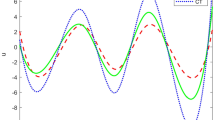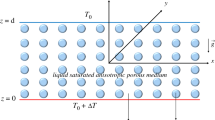Abstract
This paper presents the results of numerical analysis of a viscoplastic model for hotspot formation based on the solid-state mechanism of hotspot ignition of an energetic porous material under shock-wave loading. The highly viscous pore collapse regime is considered, which is of great interest for theoretical studies of the shock-wave initiation of heterogeneous energetic materials. Interfacial heat transfer was described under the assumption that the gas is ideal and hence homobaric (uniform in pressure). Parametric analysis was conducted, and characteristic features of the effect of heat transfer and interfacial heat transfer on the critical conditions of shock-wave initiation of chemical reaction in the energetic porous material were determined.
Similar content being viewed by others
References
B. A. Khasainov, A. V. Attetkov, and A. A. Borisov, “Shock-Wave Initiation of Porous Energetic Materials and a Viscoplastic Hotspot Model,” Khim. Fiz. 15 (7), 53–125 (1996).
A. V. Attetkov, E. V. Golovina, and B. S. Ermolaev, “Mathematical Simulation of Mesoscopic Processes of Heat Dissipation and Heat Transfer in a Two-Phase Porous Material Subjected to Shock Compression,” J. Heat Transfer Res. 39 (6), 479–487 (2008).
A. V. Attetkov, B. S. Ermolaev, and E. V. Pilyavskaya, “Effect of Interfacial Heat Transfer on the Formation of the Temperature Field in a Shock-Compressed Porous Material,” Tepl. Prots. Tekh. 3 (7), 333–337 (2011).
S. G. Andreev, “Effect of Non-Explosive Chemical Additives on the Decomposition of Energetic Materials under Low-Speed Mechanical and Shock-Wave Loading,” Khim. Fiz. 19 (2), 76–81 (2000).
V. Yu. Klimenko, A. L. Krivchenko, and A. A. Krivchenko, “Mechanism of Shock-Wave Initiation of RDX with Various Fillers,” in Shock Waves in Condensed Media: Proc. of Int. Conf. (St. Petersburg, 2008), pp. 199–208.
R. I. Nigmatulin, Dynamics of Multiphase Media (Nauka, Moscow, 1987) [in Russian].
S. Z. Dunin and V. V. Surkov, “Dynamics of Pore Closure at the Front of a Shock Wave,” Prikl. Mat. Mekh. 43 (3), 511–518 (1979).
A. V. Attetkov and V. S. Solov’ev, “Heterogeneous Explosive Decomposition in a Weak Shock Wave,” Fiz. Goreniya Vzryva 23 (4), 113–125 (1987) [Combust., Expl., Shock Waves 23 (4), 482–491 (1987)].
S. P. Kiselev, A. P. Ruev, A. P. Trunev, et al., Shock- Wave Processes in Two-Component and Two-Phase Media (Nauka, Novosibirsk, 1992) [in Russian].
R. I. Nigmatulin and N. S. Khabeev, “Heat Transfer between a Gas Bubble and a Liquid,” Izv. Akad. Nauk SSSR, Mekh. Zhidk. Gaza, No. 5, 94–100 (1974).
Author information
Authors and Affiliations
Corresponding author
Additional information
Original Russian Text © A.V. Attetkov, E.V. Pilyavskaya.
Published in Fizika Goreniya i Vzryva, Vol. 53, No. 3, pp. 106–109, May–June, 2017.
Rights and permissions
About this article
Cite this article
Attetkov, A.V., Pilyavskaya, E.V. Effect of interfacial heat transfer on the critical conditions of shock-wave initiation of chemical reaction in porous energetic materials. Combust Explos Shock Waves 53, 340–343 (2017). https://doi.org/10.1134/S001050821703011X
Received:
Published:
Issue Date:
DOI: https://doi.org/10.1134/S001050821703011X




